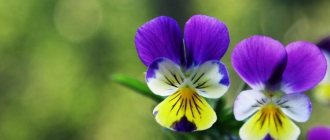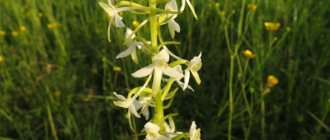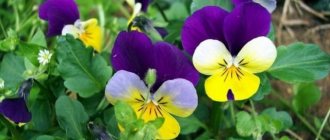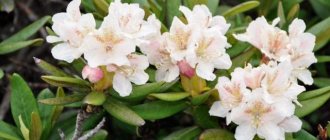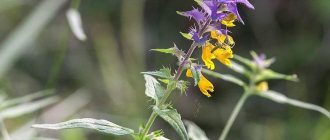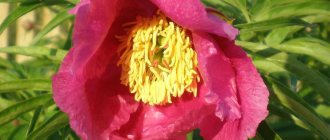When creating flower beds, flower beds and alpine slides in their garden plots, most flower growers does not forget to plant garden violets, usually using several varieties to complete the picture.
These small plants attract attention with their variety of colors against the backdrop of lush greenery and enchant with their delicate, fragile flowers and subtle trail of aroma. And the unpretentiousness of violets helps them gain even greater popularity among gardeners and landscape designers.
In the article you will learn in detail how garden violets grow - descriptions and photos of various types.
What does garden violet mean?
People have been admiring the delicate charm of violets for almost two and a half millennia, but they began to be purposefully grown and propagated to decorate gardens and parks relatively recently :
Violets have recently begun to be grown in gardens.
- In European countries, violet has been known as a garden plant since the beginning of the 16th century;
- In Russia - since the 18th century.
INFORMATIVE! Violets propagated for growing near human habitations are united by flower growers into a conventional group of garden violets. The synonymous series of this group, in addition to the name “Garden Violet”, includes the names “Viola”, “Pansy” and simply “Violet”.
Violet propagation
Indoor violets are propagated in several ways: by seeds, leaf cuttings and children. Experts recommend using vegetative propagation methods.
Reproduction with the help of children. Periodically, the violet bush produces baby rosettes. When they grow in the same pot with the main plant, they become crowded and the violet has to be replanted.
Using a leaf. This method of plant propagation is the simplest. To do this, you need to separate a healthy leaf from the second tier of the rosette and place it in water. As soon as it takes root it can be transplanted into the ground.
Bacopa - description of the species, cultivation, care, reproduction + 74 photosGarden hibiscus - types, description, planting, care and propagation + 69 photos
- Celosia - growing from seeds and seedlings, planting in the ground and care rules + 80 photos
One species or a group of different species and varieties?
Over several centuries of active cultivation of violets by flower growers of the Old World and Russia, many new species were bred - by the beginning of the 21st century, according to the Royal Horticultural Society (Great Britain), 21 species were used in gardening and landscape art.
Based on the basic species, breeders continue to grow magnificent varieties and hybrids of violas, differing in :
- Bright colors;
- Lasting aroma;
- And large flowers.
One species of garden pansy (Wittrock's viola) alone has about 500 bred forms .
Also, do not forget that white violet will look very beautiful and delicate in your gardens. The whole variety of violets used to decorate garden plots and public parks are usually called garden violets .
The most beloved and most common among garden violets are hybrid varieties of the species Viola Wittrock , called garden pansies by gardeners.
In addition, quite popular types :
- F. Graceful;
- F. Rogataya;
- F. Chinese (Manjurian);
- F. Labrador;
- F. Motley and some others.
Description of varieties
Despite the numerous species and varieties of garden violets, they have a significant number of characteristic features :
- Garden violets are mostly low herbaceous plants or small bushes;
- Many varieties have basal leaf rosette due to a shortened stem, but some are distinguished by the usual structure of the stem - then the alternate arrangement of leaves is clearly visible;
There are many colors of garden violets.
- Whole, less often weakly dissected leaves acquire an oval, heart-shaped or lobed shape. Some varieties have thick downy feathers on the leaves;
- Violet flowers are formed singly from the axils of the leaves on high stalks;
- The corolla necessarily consists of 5 petals , resembling a moth in appearance. The lower, larger petal is located in the center and rests on two sepals, the next two petals, somewhat smaller in size, sit on the sides of the lower one and each have their own sepals. The two upper petals are usually the smallest - the last sepal remains for them;
- The flowers often bear a special spur;
- The color range of violet corollas includes all possible shades of the rainbow.
Let's find out how to plant and care for perennial garden violets. You can see a photo of two-year-old Viola below.
Some varieties of biennial viola.
To facilitate their classification, all the variety of forms of garden violets are divided according to their distinctive characteristics. One of the gradation factors is the life expectancy of the plant, according to which the following groups are identified :
- Annuals - grown from seeds, live for one year, are a herbaceous plant. These include tricolor violet (can be cultivated as a biennial plant);
- Biennials - grown from seeds or cuttings, bloom in the second year, can be herbaceous or bushy. These are Viola tricolor (sometimes grown as an annual), hybrids of Wittrock's viola, as well as many perennial violets, which gardeners prefer to cultivate as a biennial;
- Perennial - grow in the form of a small bush, propagate both by seed and by cuttings or dividing the bush; they can form large clumps due to integumentary growth. The fragrant perennial garden violet has smaller buds, but blooms more profusely than the annual one. Representatives: Horned, Moth, Labrador violets.
How to grow violets at home. Plant characteristics
Indoor violet, which is also called Uzambara violet, belongs to the genus of herbaceous flowering fauna of the Gesneriaceae family. Such plants are very popular in indoor floriculture.
Violets grow naturally in East Africa. They choose places near ponds, rivers and waterfalls.
Experts identify more than 20 varieties of Uzambara violet. A representative of noble blood, Adalbert Walter Radcliffe, discovered the violet to the world back in 1892.
After purchasing a homemade violet, this plant will decorate any room for a long time. This is a perennial, evergreen representative of the plant world. The violet has a low growth and a basal rosette.
The leaves of the indoor version of the above plant are covered with numerous villi. The base of the leaves is heart-shaped, and the tip can be round or pointed, depending on the growth of the plant.
Indoor violets differ not only in the color of the flower, but also in the height and shape of the leaves. Photos of violets will clearly demonstrate the beauty of this unique plant.
The color of flowers can be varied. From light to rich and thick shades. Some varieties can combine several colors at once. If you properly care for violets, the plant will bloom throughout the year.
Planting and care
Few gardeners know when to replant garden violets. Various forms of garden violets are mostly unpretentious plants ; only some hybrids may place increased demands on certain aspects of maintenance.
Optimal location
According to their biological characteristics, garden violets can be classified as sun-loving plants with the only caveat that on hot summer days the flowers still need some shading, otherwise the leaves may wilt and darken.
Popular types of garden violets
Of the variety of varieties of garden violets, we can highlight the most popular and original types .
Tricolor
The most common species, colloquially known as “Pansy” . It has a high stem (up to half a meter), succulent leaves with wavy grooves and corollas with petals of three colors (violet, lilac and yellow). The flowers are collected in a simple brush. You can see a photo of the flower below.
Tricolor violet.
Can be cultivated as an annual or biennial crop ; perennial specimens are very rare.
Blooms in May - September.
Graceful
Abundantly flowering viola with large purple or yellow corollas on high stalks. Perennial species up to 20 cm tall with oval leaves with large teeth. Photos of flowers for you are presented below.
Graceful violet.
It blooms for a particularly long time - from spring to autumn .
Horned
The most popular perennial , often grown according to the biennial scheme. A distinctive feature is a special tail on the back of the corolla, similar to a horn. The bushes stretch up to 20 cm and can form clumps.
It has become the basis for obtaining many varieties with a full rainbow range of colors, but mostly muted tones.
Horned violet.
Flowering - from May to September . The flowers are quite large.
Labrador
A distinctive feature of the perennial is the violet tint of the juicy greenery of a dark shade. Young leaves are often purple. The violet has a ground cover stem (about 10 cm), forming lush cushions, rounded leaves and purple flowers.
Labrador violet.
Flowering later - from May to June . Viola is capable of powerful self-seeding.
Manchurian
Garden violet from the group of perennials . It has become the basis for the selection of many varieties, including those with terry corollas. It has oval-elongated dark-colored leaves, a straight stem up to 20 cm and an abundance of medium-sized purple flowers. Forms dense pillows.
Manchurian violet.
Blooms from May to June .
Moth
A perennial garden violet with oval-pointed leaves of a rich shade of green. It has the ability to instantly cover free space with curtains . The bush has long petioles and pedicels. The corollas are snow-white or purple in color.
Moth violet.
Blooms in April and blooms until the end of June .
Motley
Violet forms small bushes with a basal rosette.
A distinctive feature is the multi-colored leaves :
- The upper side has a pale venation pattern on a dark green background;
- The reverse side is usually a purple tint.
Variegated violet.
Small corollas on high stalks rise above the rosette of leaves . The color of the flower is predominantly purple with a reddish tint and white streaks.
Korean
A perennial species of garden violet, which gave rise to many hybrid varieties. It is distinguished by rounded, dense leaves with a spectacular silver pattern along the contour of the veins. The flowers are small, lilac in color with a delicate aroma. Grows from 20 to 40 cm.
Korean violet.
Flowering period - April and May .
Ivy-shaped
A perennial garden violet with strongly intertwined, ground-covering stems and numerous rounded leaves . Corollas of white and lilac color rise above a solid carpet of greenery on high stalks.
Ivy violet.
Diseases and pests
Homemade violets practically do not get sick, but you need to be aware of possible diseases:
- Late blight. It is most dangerous for the plant and occurs due to high soil and air humidity. You can notice it by brown spots on the stem and leaves. In this case, the plant cannot be saved; it will have to be destroyed so as not to infect other flowers. The soil should also be thrown away and the pot sterilized.
- Root nematode. This pest destroys the root system of the flower, and the violet dies. Lives in the ground. As a preventive measure, it is better to plant violets in purchased soil.
- Thrips are small insects that appear on the underside of leaves. Leaves affected by thrips must be removed in time - this will save the flower from death.
In conclusion, we can say that the beautiful Le Chantal will not leave anyone indifferent. Judging by the photo and description of the Le Chantal violet, the flower is not only beautiful, but also not too capricious, it is easy to grow at home.
Application in landscape design
Varieties of garden violas, bred as a result of breeding work, are distinguished by lush greenery , a variety of colors and rather large corollas, but at the same time they continue to retain the charm of forest flowers.
Their enviable advantages include :
- Unpretentiousness in content;
- Ability to grow as ground cover;
- And the possibility of long-term and repeated flowering.
Therefore, varieties of garden violets are suitable for creating absolutely any landscape shape . They look great in prefabricated flower beds, flower beds, borders and lawns.
With their help, you can create a variety of alpine slides and multi-colored curtains for decorating park areas. Garden violas also serve as an excellent material for creating borders and vertical compositions.
IMPORTANT! Garden violets can be used both as independent decoration objects and in various combinations with other cultivated and forest plants.



